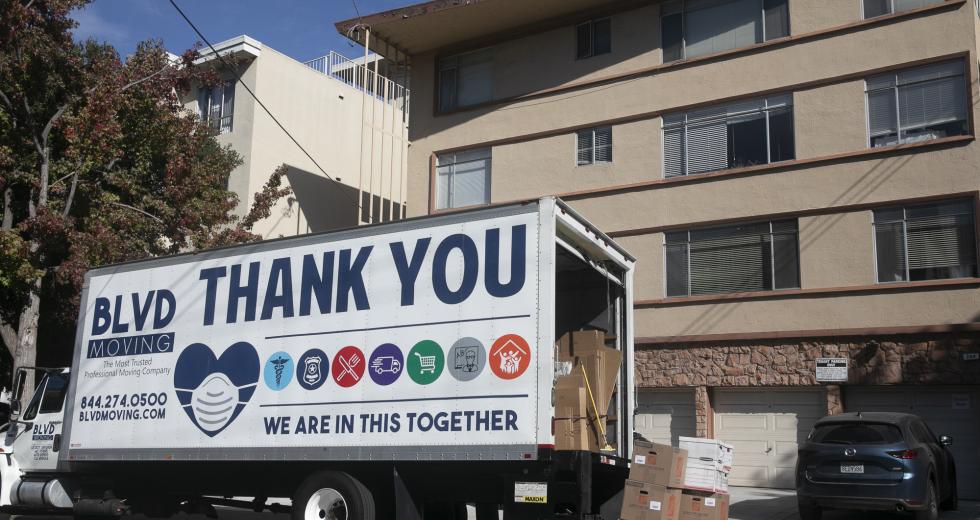When a strange and deadly virus shut down Hollywood last March, Alexander Shea knew he had to move fast. But to where?
The 24-year-old actor and usher at Beverly Hills’ Wallis Annenberg theater was out of work overnight. Soon, the whole economy shut down. When rumblings about closing state borders got louder, Shea piled what he could in his Mustang and left his $1,500-a-month, 390-square-foot Glendale apartment for his hometown.
“My girlfriend and I were in the car with our dog driving to St. Louis,” Shea said. “I got like three hours of sleep in two days.”
Stories of mid-pandemic moves like Shea’s have reignited familiar fears about California residents and businesses fleeing for more affordable alternatives, especially with added remote work flexibility. But new moving data and unusually busy California real estate agents cast doubt on the exodus panic that’s taken hold in the press and far-right social media circles. Perhaps the better questions are whether the shifts are temporary, or what might happen once the state’s eviction moratorium lifts.
A new report released Thursday by the California Policy Lab, a research arm of the University of California, found “no evidence of a pronounced exodus from the state,” nor data to suggest that large numbers of wealthy residents are leaving. Two notable exceptions: the city of San Francisco saw a large year-over-year loss, and the state as a whole saw more departures and fewer arrivals in the final quarter of 2020. Some 267,000 people left California around the end of the year, compared to just 128,000 people moving in from other states.
“To date the pandemic has not so much propelled people out of California as it has shifted them around within it,” according to the report. “The absence of a pronounced exodus from the state should come as a relief to people concerned about effects on state tax revenues.”
The decision to move has always been highly personal — subject to work, family ties, lifestyle preferences and a million other variables — and official federal moving data takes years to compile. In California, the nation’s most populous state with some 40 million people, the number of things happening at once can make things even murkier.
The remote work crowd is just starting to confront the prospect of salary cuts if moves to lower-cost locales become permanent. Arts advocates warn of a “cultural depression” after 175,000 creative jobs vaporized during the pandemic. For Californians barely hanging on, breakdowns in the state’s job safety net are colliding with long-running failure to build affordable housing or accurately count people forced into precarious situations like couchsurfing or living in cars. Through it all, the state wound up with $26 billion more than expected, thanks largely to tax receipts from wealthy individuals who are still here.
What we know so far about the much-discussed California Exodus is a patchwork. The new California Policy Lab analysis is based on credit reporting data, which doesn’t necessarily catch movement among young people with little credit history, or some very low-income or marginalized groups. U.S. Postal Service data recently analyzed by the San Francisco Chronicle showed that Bay Area movers overwhelmingly stayed in the region. Companies like Zillow and U-Haul have offered up their own partial data, and a cottage industry of online moving groups say they’re flourishing with ideological pitches to move to Texas, Idaho or beyond.
“The traditional data sets that we use to look at residential mobility are great, but they’re not very frequent,” said Natalie Holmes, the UC Berkeley doctoral student who authored the lab’s report, opening the door to more anecdotal reports. “I have a friend who’s in an Airbnb in Tahoe, because she can work remotely,” Holmes said. “These are all capturing slightly different concepts of where people live.”
New Booms and Busts
Until recently, San Francisco was often in the headlines for being one of the most expensive places in the world to live. But since last March, the number of people leaving the city on net jumped an eye-popping 649% compared to the same period in 2019, based on the California Policy Lab’s analysis of address information filed with credit card companies and other financial agencies. About 80% of those 38,800 people stayed within the region, though counties in the Sierras like El Dorado, Placer and Nevada also saw sizable gains. The report does not say where those who left the state moved.
“It feels like people around here have kind of accepted this ridiculous, expensive market, and they want more of it.”
HEIDI HART, OWNER OF CALIFORNIA DREAMING REAL ESTATE
The in-state shuffling is already leading to new booms in some corners of California. High in the Santa Cruz Mountains, not even the combination of a pandemic and a summer wildfire that burned down 900 homes has slowed real estate bidding wars. As far as Heidi Hart can tell, all the anxiety has actually supercharged the housing market.
“It feels like people around here have kind of accepted this ridiculous, expensive market, and they want more of it,” said Hart, fresh off her best year ever as owner of Santa Cruz County’s California Dreaming Real Estate. “It’s like it’s a drug or something. There’s money coming out of the woodwork from everywhere.”
Houses in Santa Cruz County are getting up to 20 offers and selling for hundreds of thousands of dollars over the asking price, Hart said, in large part because there are fewer options. She currently has 25 homes listed for sale, compared to the usual 100 or so this time of year. About 60% of buyers are coming from the Bay Area to take advantage of remote work, Hart estimates, some putting up inherited cash or tech stock proceeds to make offers more attractive. Most sellers are staying close to home, at times transferring low property taxes guaranteed by California’s Proposition 13 to bigger houses, but a few have cashed out for Utah or Idaho.
The sense of scarcity is more acute at lower price points, which are harder for researchers and official counts like the census to track. As home bidding wars rage on, would-be renters in Santa Cruz post on Craigslist about doing “the parking lot shuffle” while living in their cars — a precarious situation unemployed Californians in other parts of the state are living through, too.
Roughly 2,000 miles away in Missouri, Shea and his girlfriend are somewhere in the middle of these extremes. Nearly a year after the pair left LA to move in with family, he still spends hours fighting California bureaucrats over what he estimates is around $8,000 in unpaid unemployment benefits.
As for what comes next, an acting agent gave him a lead in Atlanta, where California rent might translate to a mortgage payment. He’s even considered moving to New Zealand.
But there’s one other appealing alternative: “If things go well,” Shea said, “I’ll just move back to LA.”
For the record: This story has been corrected to reflect that the California Policy Lab found a 649% net increase in San Francisco residents moving out since March 2020.
CalMatters.org is a nonprofit, nonpartisan media venture explaining California policies and politics.
–
Stay up to date on the effects of the coronavirus on people and business in the Capital Region: Subscribe to the Comstock’s newsletter today.
Recommended For You

Is the Business Exodus to Texas Real?
Comstock’s president and publisher considers the apparent exodus from California to states such as Texas.

Boom From the Bay
The influx of high-skilled workers is boosting Sacramento’s economic prospects
Leaders in business and development say the trend could alter the trajectory of the region’s economy for years to come.

A Move to Midtown Might Not Be in the Cards
To open our annual housing issue, Comstock’s executive editor weighs the pros and cons of moving to Midtown Sacramento.

How the Remote Work Revolution Could Change California’s Housing Crisis
A huge number of people have been working from home for the better part of the year. The long-term implications for housing will likely benefit higher-earning workers and hurt lower income Californians.



